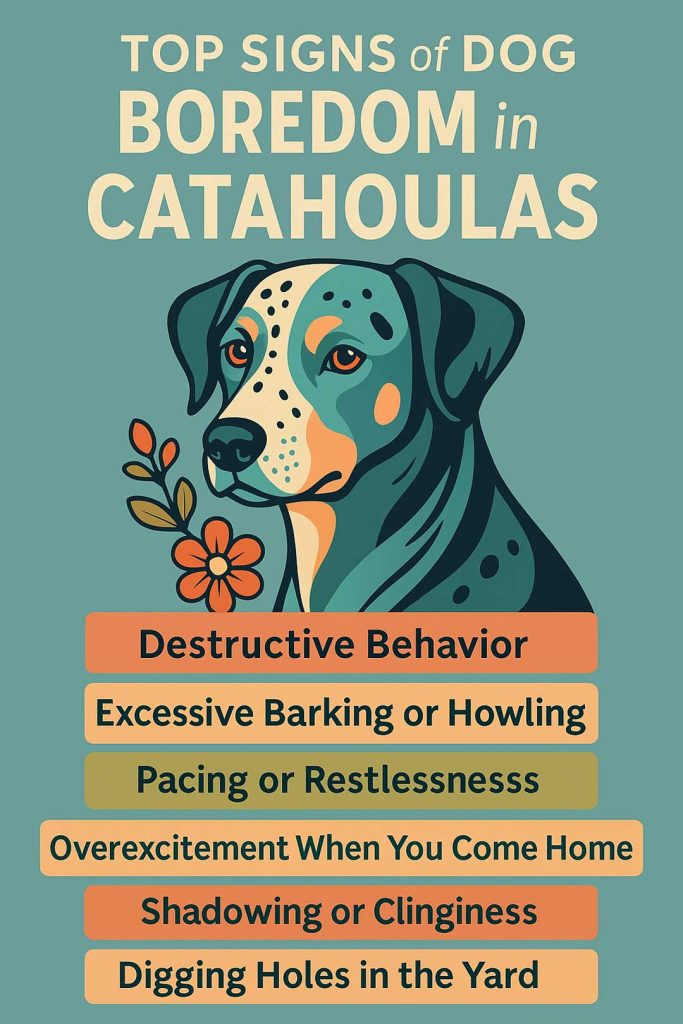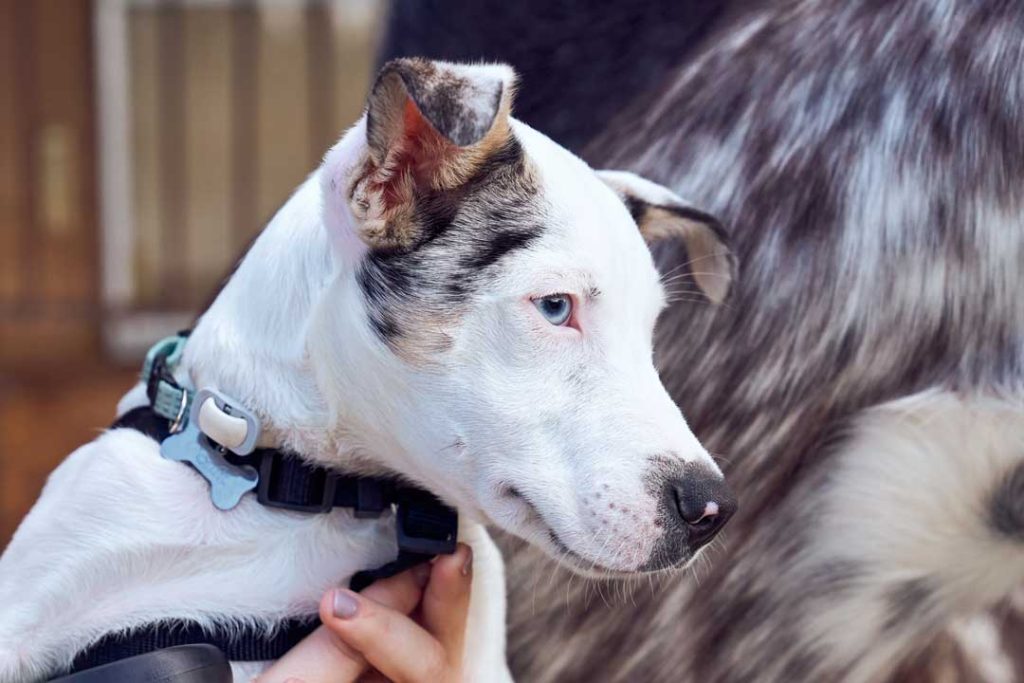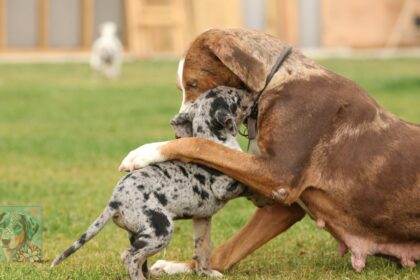The signs of dog boredom in a Catahoula are loud, messy, and easy to miss—until your couch pays the price.
Catahoulas are smart, high-energy, and always ready for action. But when boredom strikes? Trouble follows. From digging craters in your yard to barking at shadows, these pups know how to make their feelings known.
The signs of dog boredom are easy to spot—once you know what to look for. Thankfully, you can fix it with a little creativity and a lot of love. Let’s dig into the signs and solutions that’ll keep your Catahoula happy, healthy, and out of the trash can.
Why Catahoulas Get Bored So Easily
Catahoulas are born to work. They’re smart, strong, and always on the move. Originally bred as herding and hunting dogs, they thrive on action and challenge. Without enough to do, they get bored—and fast.

Because they’re so intelligent, basic toys or walks won’t always cut it. They crave mental stimulation just as much as physical exercise. Otherwise, they’ll create their own “fun” (hello, shredded pillows).
That’s when the signs of dog boredom creep in. Chewing, digging, and barking aren’t just bad habits. They’re often cries for attention or activity. Unfortunately, many dog owners miss these early signals.
Over time, boredom can turn into frustration, anxiety, or even aggression. That’s why it’s so important to recognize the early Catahoula dog behavior changes. Spotting the signs early helps you fix the root cause—not just the symptoms.
Catahoula Mom Tip: A tired Catahoula is a happy Catahoula… and a lot less likely to eat your drywall.
Catahoulas aren’t couch potatoes. They need jobs, games, and purpose. With the right routine, you’ll prevent those common bored dog behaviors—and keep your pup smiling (and your house intact).
The Top Signs of Dog Boredom in Catahoulas
Catahoulas don’t do “lazy.” When their bodies and brains don’t get what they need, boredom takes over—and it shows fast.

Below are the most common signs of dog boredom that Catahoula owners run into. Recognizing these early can help you redirect that wild energy before it turns into a full-blown house-wrecking mission.
Destructive Behavior
Catahoulas love to use their mouths—and when they’re bored, nothing is safe. Chewed baseboards, ripped beds, and destroyed toys all point to a lack of stimulation.
If your pup is tearing through your home like a tornado, it’s time to give their brain and body a new challenge.
Excessive Barking or Howling
Every little sound sets them off. They bark at leaves, neighbors, or just the wind. This vocal overload often signals boredom or frustration. It’s your Catahoula’s way of saying, “Hey, I need something to do!”
Pacing or Restlessness
They circle the house. They jump from couch to window to door. This constant movement means they have energy to burn. Catahoulas weren’t bred to sit still—they need jobs, games, and adventure.
Overexcitement When You Come Home
You walk in and your dog explodes with energy—jumping, mouthing, zoomies galore. While it’s cute, it can also mean they’ve been bored and waiting all day for action. A well-exercised pup tends to greet you a little more calmly.
Shadowing or Clinginess
Your Catahoula becomes your shadow, glued to your side every second. This isn’t just affection—it’s often boredom or anxiety. If they can’t relax on their own, they probably need more mental stimulation during the day.
Digging Holes in the Yard
One hole? Maybe. But if your backyard looks like a minefield, you’ve got a bored digger on your hands.

Digging is instinctual, but excessive digging usually means they’re trying to entertain themselves—and you might not love their idea of fun.
Obsessive Licking or Tail Chasing
When dogs obsess over licking their paws or chasing their tails, it’s often stress or excess energy. These repetitive behaviors are self-soothing habits that can point to a bigger issue—like not having enough to do.
Lack of Interest in Toys
Even their go-to squeaky toy doesn’t get a tail wag anymore? That’s a red flag. When Catahoulas ignore playtime, it may mean they’re under-stimulated or need a new challenge to get excited.

Boredom doesn’t just sneak in—it shows up loud and clear when you know what to look for.
These common signs of dog boredom are your Catahoula’s way of waving a paw and saying, “I need more!”
The good news? Once you spot the signals, you can take action.
Let’s look at simple, effective ways to bust boredom and keep your Catahoula’s tail wagging for all the right reasons.
How to Fix It: Mental Stimulation for Your Catahoula
Mental exercise is just as important as physical activity—especially for clever, working dogs like Catahoulas. Without enough brain games or challenges, boredom builds fast.
That’s when those signs of dog boredom start to pop up. But with a few simple tools and routines, you can turn a bored pup into a focused, happy companion.
Puzzle Toys and Treat-Dispensing Games
DIY Scent Work Games (Hide-and-Sniff)
Training Sessions for New Tricks or Commands
Short, daily training sessions challenge your dog’s brain and build your bond. Whether it’s learning “spin,” “stay,” or even fun tricks like “crawl,” they love the mental challenge.
Dog-Friendly Brain Games
Try simple games like the cup shuffle (where’s the treat?), or “which hand has it?” These keep your Catahoula focused, engaged, and out of mischief.
Catahoula Mom Tip: “Catahoulas love using their brains. If you don’t give them a job, they’ll find one—usually one you won’t like.”
How to Fix It: Physical Exercise Ideas That Actually Work
Catahoulas were built to move. They’re not just energetic—they’re athletic, strong, and made for adventure.
If you’re seeing signs of dog boredom, there’s a good chance your pup needs more physical activity. Here are exercise ideas that work with your Catahoula’s natural instincts and high drive.
Long Walks, Hikes, or Trail Runs
Don’t just walk around the block. Take your Catahoula on a longer adventure. Nature trails, wooded parks, or beach walks help burn energy and satisfy their curiosity.

Structured Playtime Like Fetch or Tug
A game of fetch isn’t just fun—it builds focus and wears them out fast. Tug is also a great energy outlet that works indoors or outside.
Agility Training in Your Backyard
Set up a DIY agility course with tunnels, jumps, or weave poles. These dogs love a challenge and excel when they’re given a “job.”
Swimming or Dock Diving
If your Catahoula likes water, this is gold. Swimming is low-impact but high-energy, and dock diving adds a thrilling twist they’ll beg to repeat.
Off-Leash Play at Secure Parks or With Doggie Friends
Social time with other dogs is great for energy release and mental stimulation. Just make sure it’s a safe, fenced area where they can run freely.
Catahoula Mom Tip: “Zoomies in the house? That’s your Catahoula saying it’s time to hit the trails.”
Build a Boredom-Busting Routine
Catahoulas thrive on structure. When they know what to expect, they’re calmer, happier, and less likely to destroy your couch out of boredom.

A solid daily routine keeps their body active and their mind sharp. Here’s a simple rhythm to follow that works for most Catahoulas—and their humans too.
Morning Movement: Start the Day with a Walk or Run
Begin with a solid energy burn. A brisk walk, trail run, or quick backyard session sets the tone for a balanced day.
Midday Mental Challenge: Puzzle Toy or Chew
Before boredom creeps in, offer a brain game. Puzzle feeders, treat toys, or a tough chew can hold their attention while you work or run errands.
Afternoon Check-In: Quick Training Session or Play Break
Just 10–15 minutes of engagement makes a big difference. Work on commands, toss a ball, or play tug to reset their focus.
Evening Bonding: Snuggles, Brushing, or More Active Play
Wind down together with affection and calm play. Whether it’s a brush-out session or a final round of fetch, they’ll feel connected and relaxed.
When It’s More Than Boredom
Sometimes, the signs of dog boredom might point to something deeper. If your Catahoula’s behaviors feel extreme, constant, or out of character, it could be more than just a case of the blahs.

Anxiety, frustration, or even underlying medical issues can show up in similar ways.
If the chewing, pacing, or barking doesn’t improve—even after adding more activity and stimulation—it’s time to check in with your vet.
A professional trainer or behaviorist can also help if things feel out of control. You know your dog best. When something feels off, trust your gut and don’t wait too long to ask for support.
Final Thoughts from The Catahoula Mom
Our spotted sweethearts are smart, sassy, and full of energy. It can be overwhelming—but it’s also what makes them so special. Once you start recognizing the signs of dog boredom, everything changes. You’ll be able to meet their needs, redirect their wild energy, and enjoy a calmer, happier home (with fewer chewed-up shoes).
Whether you’re using puzzle toys, trail runs, or scent games, there’s no one-size-fits-all answer—but there is always something that works.
Now it’s your turn! What’s your go-to boredom buster for your Catahoula? Drop it in the comments below—we’d love to hear your tips and stories!

Common signs include destructive chewing, digging, barking, pacing, and restlessness. Bored Catahoulas often become clingy, overly excited, or disinterested in their usual toys.
Use puzzle toys, scent work games, and short training sessions. Rotate enrichment activities to challenge their brain and avoid routine boredom.
Most Catahoulas need at least 60–90 minutes of physical activity daily, plus mental stimulation through games or training.
Durable toys like the Kong Extreme, snuffle mats, and treat-dispensing puzzles are top picks. Choose toys that challenge both mind and mouth.










Great articles, we rescued Buddy & enjoy learning about the breed.